-
- Abundante
- Adquirentes de pagos
- Ajustes
- Analítica
- Citas en línea
- Comercio Electrónico del Sitio Web de Odoo
- Configuración el Sitio Web de Comercio Electónnico
- Diseñe la Página de Su Sitio Web
- Gestión de Productos
- Gestión de Varios Idiomas
- Grupos
- Herramientas de fragmento
- Lista de precios
- Listado de productos
- Métodos de envío
- Múltiples compañías
- Múltiples sitios web
- Operaciones de blog en backd
- Pedido
- Personalización de la Página del Catálogo de productos
- Personalización del catálogo de productos
- Personalizar el menú y las apariencias
- Porcos
- Programas de cupón y promoción
- Publicar contenido específico para el sitio web
- RedirracionAmiento
- Salas de chat
- Sesión de Productos en la PESTAÑA CONFIGURACIÓN
- Sitio Web
- Tablero de Comercio Electrónico
- Tarjeta de Regalo
- Twitter Wall
- Visitantes
- Vistas de la Página
-
- Activo
- Adquirentes de pagos
- Biblioteca de contabilidad
- Catálogo de cuentas
- Conabilidad miscelána
- Configuración de Datos Bancario
- Contabilidad
- Contábilidad analíta
- Diario
- Estados de Cuenta Bancario
- Factura de Clientes al Pago
- Fechas de Bloqueo
- Fiscales de posiciones
- Gastos de Empleados
- Informa de de Socios
- Informa de seguimiento
- Informa en contabilidad
- Ingresos y Gastos Diferidos
- Mandatos de débito directo
- Notas de Crédito
- Pagos
- Pagos por lotes
- Presupuesto
- Reconciliatura
- Redondeo en efectivo
- Tablero de contabilidad
- Tipos de contabilidad
- Transferencias automáticas
- Términos de Pago
-
- Abundante
- Adquisico de Plomo
- CREACIÓN DE COTIZACIONES DE VENTAS
- CRM
- Caracteríssticas de Odoo 15 CRM
- Convertir LOS Cables en Oportunidades
- Cómo Odoo CRM Gestiona Las Oportunidades Perdidas
- FluJo de trabajo general de Odoo CRM
- Formulario de generación de plomo múltiples fuentes
- Funcionando -Con Clientes Potenciales
- Manejo de Liderazgo
- Nuevas Opciones en la ventana de configuración de Odoo 15
-
- Análisis de producción
- CREANDO CENTROS DE TRABAJO
- Fabricación
- Facturas de materiales
- Gestión de Chatarra
- Gestión de Mantenimiento
- Gestión de órdenes para no consultor
- Informe General de Efectividad del Equipo
- Pedidos de Fabricación
- Planificación de Pedidos Laborales por producción
- Planificación de órdenes de Trabajo por WorkCenter
- Programa de producció Maestra
- Órdenes de Trabajo
-
- Abundante
- Ajustes de Inventario
- Anuncios
- CARACTERÍSTICAS DEL MÓDULO DE INVENTARIO DE ODOO
- Categorizacia de productos
- Categorías de Almacenamiento
- Configuración del producto
- Confirmación de SMS en la Entrega
- Confirmación por Correo Electrónico en la Entrega
- Costos de Aterrizaje
- Empaquetado del producto
- Entrega
- Entregar Paquetes
- Estategias de Eliminación
- Gestión de Almacenes
- Gestión de Chatarra
- Integrando el Remitente de Terceros en Odoo
- Inventario
- Operaciones de inventario
- Planificadores
- Reglas de Caída
- Reglas y rutas
- Tiempos de Programació
- Trazabilidad del Producto
- Ubicacia
- Unidad de Medida
- Variantes de productos
-
- APEGO Salarial
- Abundante
- Configuración
- Contratos
- Entradas de Trabajo
- Estructuras salariales
- Información personal
- Nómina de Odoo
- OTROS TIPOS DE ENTRADA
- Parámetros de la regla salarial
- Reanudar
- Salarios de reglas
- Salpicaduras
- Tablero
- Tiempos de Trabajo
- Tipo de estructura salarial
- Tipos de Entrada de Trabajo
- Ventajas
Inventory- Odoo 15 Enterprise Book
Product Categorization
La función de categorización de productos disponible en el módulo de inventario de Odoo le permitirá clasificar su lista de productos.Esta característica avanzada es muy útil para administrar las operaciones de su producto.Usando esta opción, puede enumerar fácilmente los productos basados en las categorías de ventas y compras.Además, la opción Categoría del producto será muy útil para la categorización de Departamento en diferentes niveles de una empresa.
Puede acceder fácilmente al menú Categoría de producto desde la pestaña Configuración del módulo de inventario Odoo.
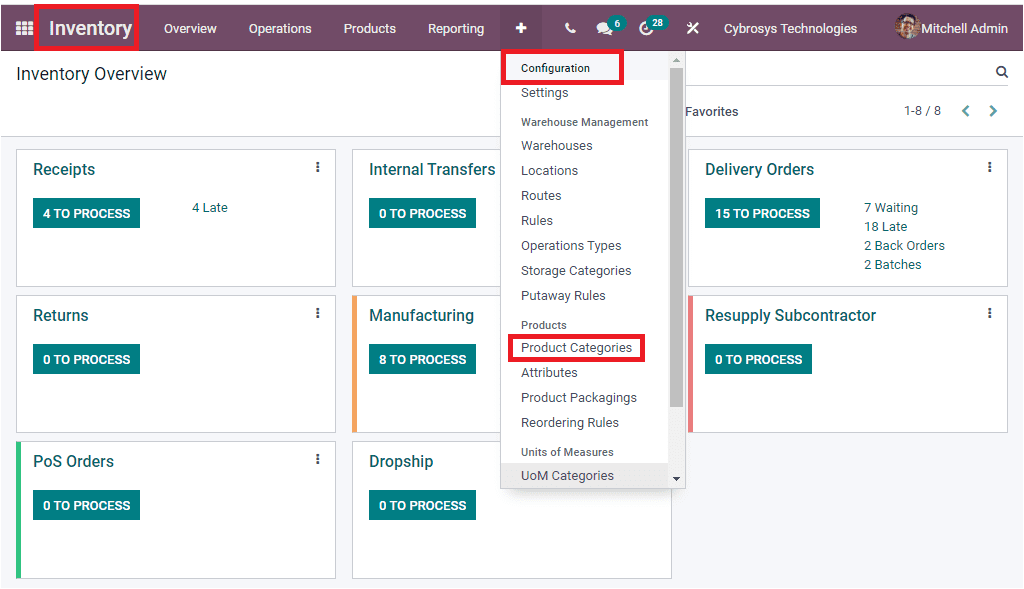
La imagen de la ventana Categorías de productos se muestra a continuación.
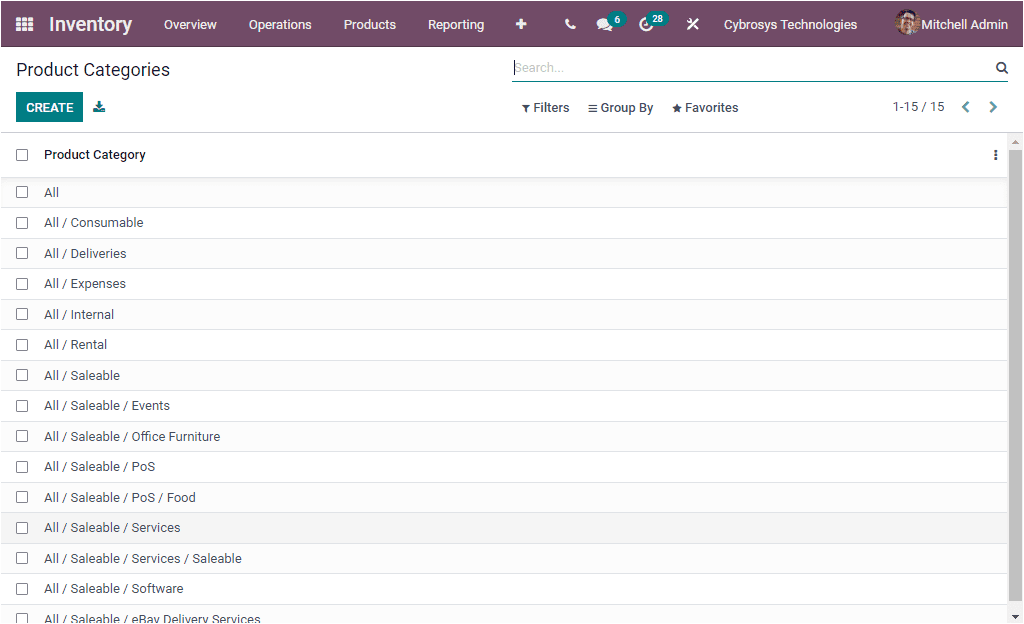
La ventana Categorías de productos comprenderá todas las categorías descritas en el sistema Odoo.Tiene la disposición para ver cada una de las categorías en detalle haciendo clic en la respectiva.También puede editar los detalles si es necesario.Para crear nuevas categorías, puede seleccionar el icono Crear al que se puede acceder desde la esquina superior izquierda de la ventana Categorías de productos.La imagen de la ventana de creación de categorías de productos se muestra a continuación.
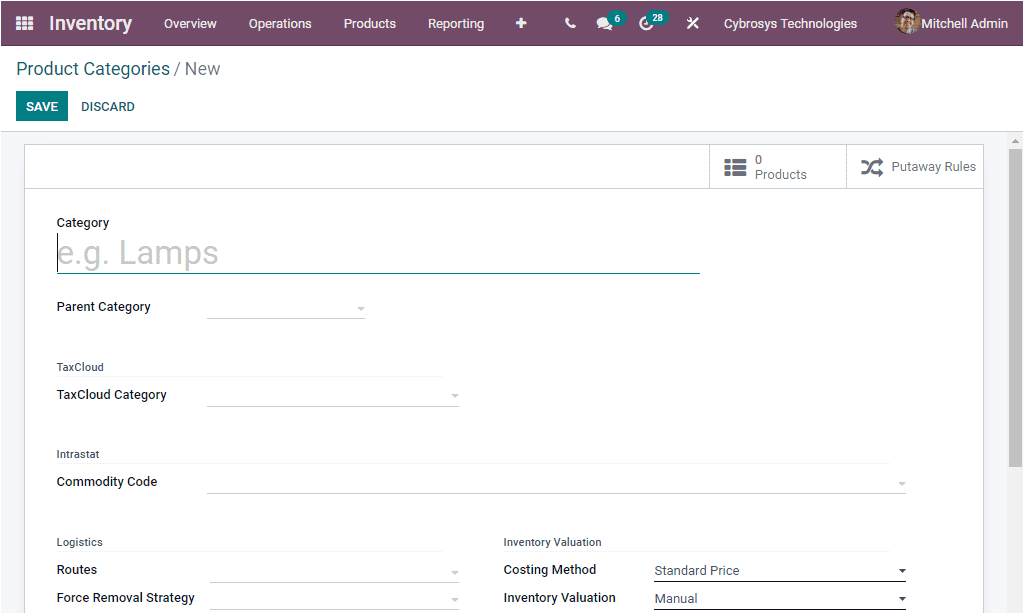

En el formulario de creación de categoría de producto, puede dar el nombre de la categoría junto con la categoría principal. Luego puede asignar la categoría TaxCloud. Esta categoría de TaxCloud se refiere a los Códigos de información de impuestos sobre la impuestos (TIC). TaxCloud utilizan estos para calcular tasas impositivas específicas para cada tipo de producto. Este valor se usa cuando no se establece TIC en el producto. Después de asignar este campo, puede especificar el código de productos básicos. Además, puede describir los aspectos logísticos de la categoría de productos, como las rutas, la estrategia de eliminación de fuerza y los empaques de reserva. Además, las terminologías de valoración de inventario y el método de coste se pueden especificar en función de los principios de su organización. El método de costo es la herramienta confiable disponible en Odoo, que le permitirá obtener un informe sobre cuánto gasta en productos. Con esta herramienta efectiva, puede administrar fácilmente la descripción del precio del producto en función de los diversos aspectos de la compra y los cargos adicionales conectados con la logística. Odoo le permite tres tipos de metodologías de costo de productos y son el
- Standard Price
- Average Cost (AVCO)
- First In First Out(FIFO)
En el caso deStandard Cost, the products are assessed based on their standard cost defined in the product where the product pricing is described standard as defined by the user. If there is any product in Odoo which has not been defined any costing method will be assigned to this category. When we come to the Average Cost, it will allow you to define the cost of the product based on the average cost of the entire product quantity. The First In First Out method is mainly for costing aspects and product removal aspects. In this case the products are operated based on the policy that the first entered product in the company will also leave first.
Ahora tenemos que completar el aspecto de valoración de inventario de la categoría de productos.
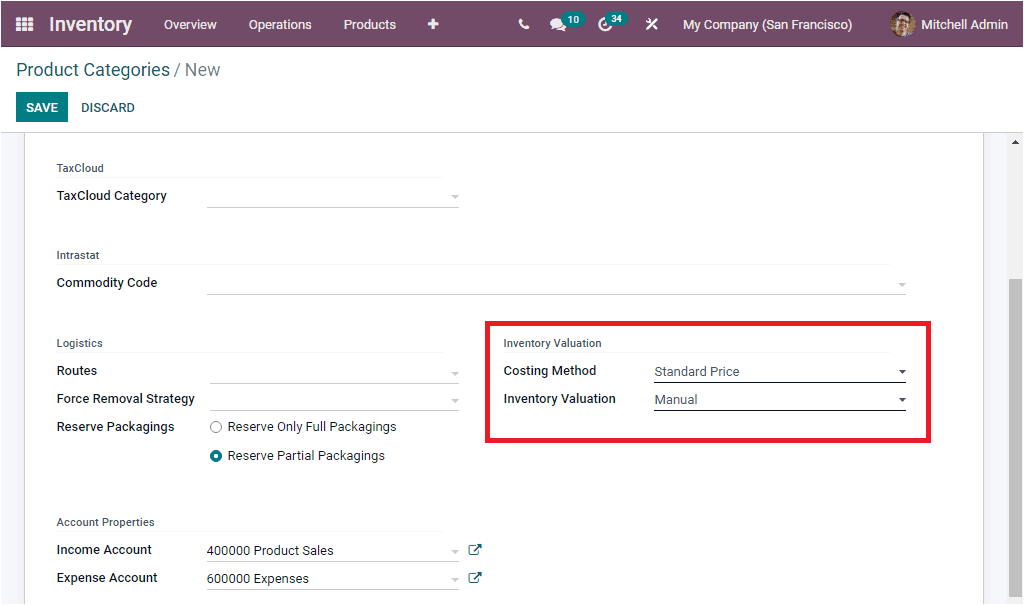
Inventory valuation is one of the important features in Odoo as it denotes how you value your stock and the method used to identify the accurate value of the inventories at the end of a financial period. Having an accurate inventory valuation is very important for a company. It is the reported stock or inventory calculation that determines the expense of sold products, whole profit, total gain in the income statement. An accurate inventory valuation will help you to calculate the actual income and true financial position of the company.
Odoo helps you to have two types of Inventory Valuation. That is Manual and Automated. In the case of Manual, the accounting entries to value the inventory are not posted automatically. In the Automated option, an accounting entry is automatically created to value the inventory when a product enters or leaves the company.
After defining the Inventory Valuation you have to mention the Account Properties in the Product Categories creation window.
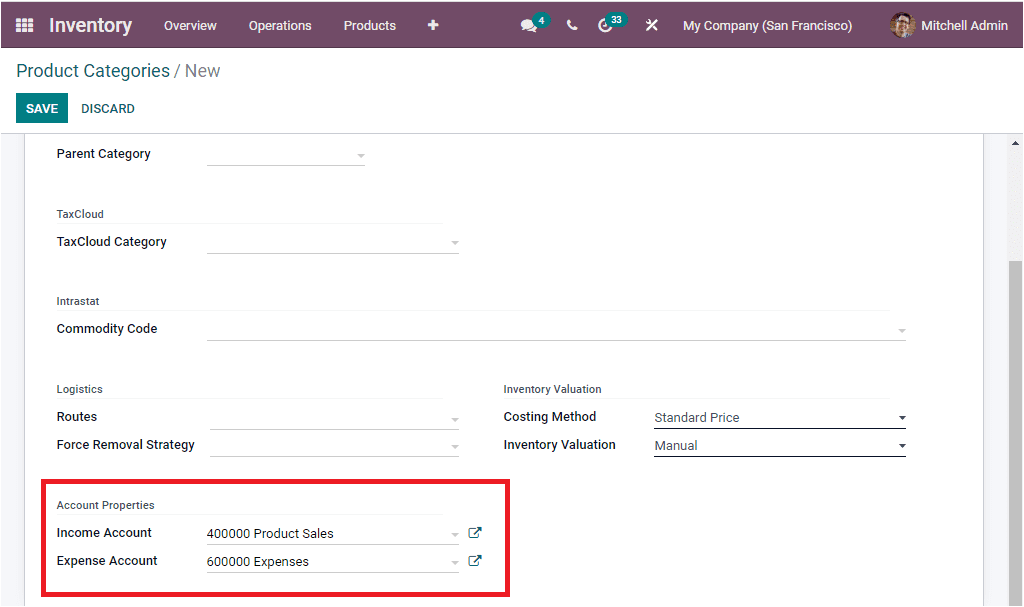
If the Inventory Valuation is set as Manual, the Income Account and Expense Account in the Accounting properties section can be managed. If you set up Inventory Valuation as Automated, we will have to fill the Accounting properties in detail.
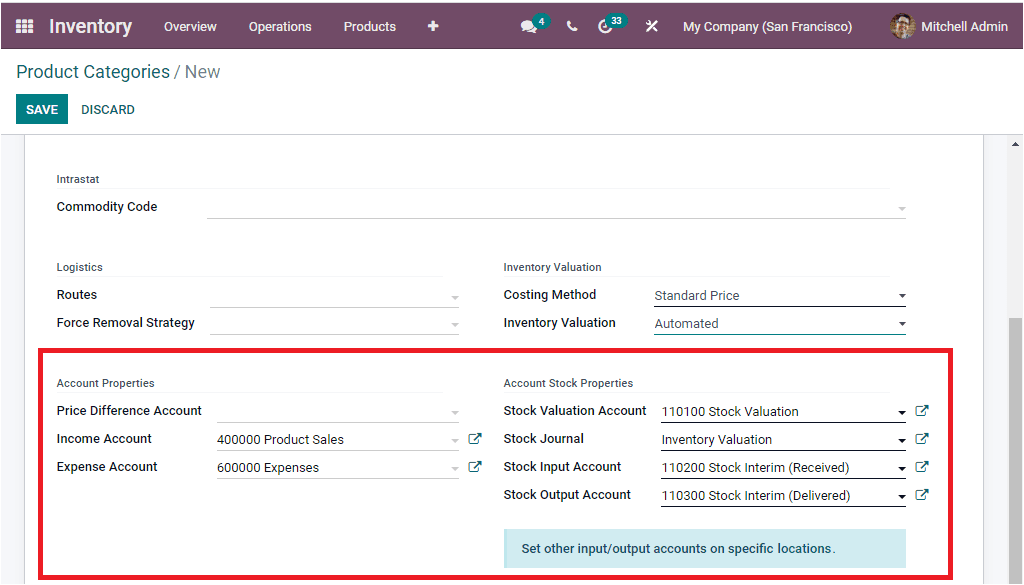
Now we have two sections as Accounting Properties and Account Stock Properties. In the Accounting Properties section, you have to fill up the
Price Difference Account: The Price Difference Account can be used to value the price difference between the purchase price and accounting cost.
Income Account: The Income Account is used to validate the invoice of the customer.
Expense Account: The Expense Account is mainly used when a vendor bill is validated.
In the Account Stock Properties section you have so many fields and these are the following
Stock Valuation Account: This field will represent the current value of the product when automated inventory valuation is activated on a product
Stock Journal: When doing automated Inventory valuation, this is the accounting journal in which entries will be automatically posted when stock moves are processed.
Stock Input Account: Here in this account, you can enter all the incoming stock details.
Stock Output Account: The Stock Output Account is used to record outgoing stock movements. So we can manage accounting information using product categories. We are also able to set income accounts and expense accounts for product and product categories. However, while managing the operations, the account set in the product will be considered. If there is no account set for the product the Odoo system will automatically select the income and expense account that we set for the product category.
So far we were discussing the Product Categories window available in the platform and now let us have a look into how Odoo will help you to manage deliveries.